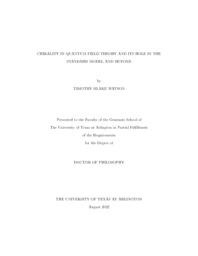
ATTENTION: The works hosted here are being migrated to a new repository that will consolidate resources, improve discoverability, and better show UTA's research impact on the global community. We will update authors as the migration progresses. Please see MavMatrix for more information.
Show simple item record
| dc.contributor.advisor | Zdzislaw, Musielak E | |
| dc.creator | Watson, Timothy Blake | |
| dc.date.accessioned | 2022-09-15T14:07:05Z | |
| dc.date.available | 2022-09-15T14:07:05Z | |
| dc.date.created | 2022-08 | |
| dc.date.issued | 2022-08-12 | |
| dc.date.submitted | August 2022 | |
| dc.identifier.uri | http://hdl.handle.net/10106/30984 | |
| dc.description.abstract | Chirality as a symmetry of particle physics occupies a unique role in the standard model. It arises from general space-time principles yet remains central to the formulation of local gauge theories. This work explores the complexities arising from a physically comprehensive treatment of this topic. We present the origins of the property from first principles by deriving the chiral Dirac equation (CDE). We demonstrate how the resulting chiral degrees of freedom for spin-1/2 objects may be employed in constructing composite chiral objects through the Bargmann-Wigner formalism, leading to novel couplings. We then consider means by which the degrees of chiral freedom in the standard model may be spontaneously broken through left-chiral Majorana neutrino fields. The resulting modifications to standard model processes are explored before a final exploration of chirality in curved space-time. | |
| dc.format.mimetype | application/pdf | |
| dc.language.iso | en_US | |
| dc.subject | Chirality | |
| dc.subject | Bargmann-Wigner | |
| dc.title | CHIRALITY IN QUANTUM FIELD THEORY AND ITS ROLE IN THE STANDARD MODEL AND BEYOND | |
| dc.type | Thesis | |
| dc.contributor.committeeMember | Weiss, Alexander H | |
| dc.contributor.committeeMember | White, Andrew | |
| dc.degree.department | Physics | |
| dc.degree.name | Doctor of Philosophy in Physics and Applied Physics | |
| dc.date.updated | 2022-09-15T14:07:06Z | |
| thesis.degree.department | Physics | |
| thesis.degree.grantor | The University of Texas at Arlington | |
| thesis.degree.level | Doctoral | |
| thesis.degree.name | Doctor of Philosophy in Physics and Applied Physics | |
| dc.type.material | text | |
| dc.creator.orcid | 0000-0002-8631-2253 | |
Files in this item
- Name:
- WATSON-DISSERTATION-2022.pdf
- Size:
- 776.2Kb
- Format:
- PDF
This item appears in the following Collection(s)
Show simple item record


